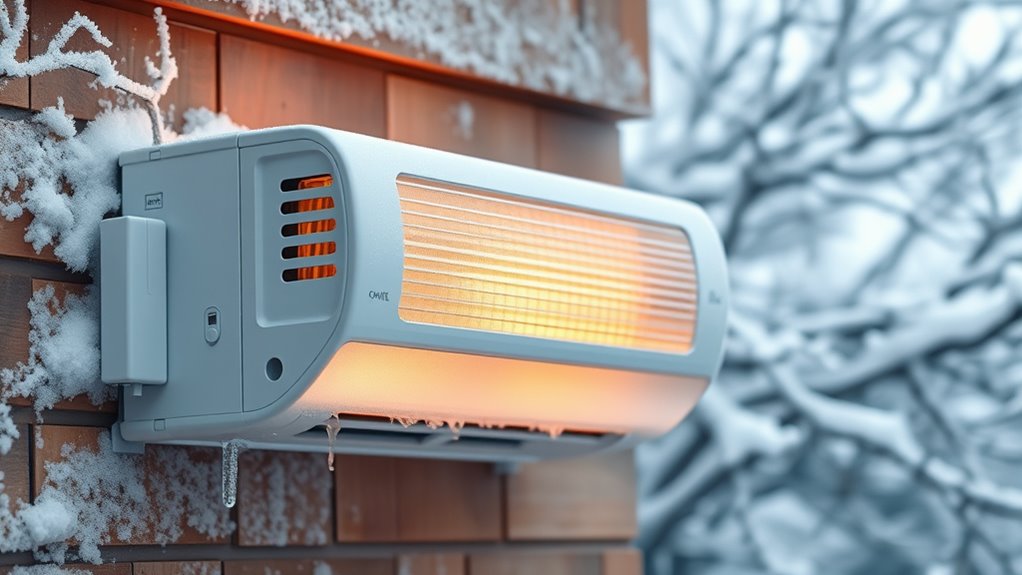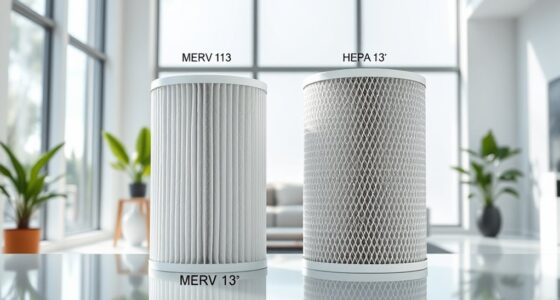When your mini-split enters defrost mode during winter, it’s a normal process that prevents ice from forming on the outdoor coil, which could reduce heating efficiency. The system temporarily reverses to warm the coil and melt any ice buildup, often stopping the outdoor fan and running in heating mode indoors. This cycle usually lasts just a few minutes. Understanding this helps you recognize it’s a sign of proper operation—if you want to know more, keep exploring how your system works.
Key Takeaways
- Defrost mode prevents ice buildup on the outdoor coil by temporarily reversing the system to warm the coil.
- It is a normal, short cycle that occurs during winter to maintain system efficiency.
- During defrost, the outdoor fan stops, and the indoor unit continues heating to melt ice.
- Regular defrost cycles are essential for optimal mini-split performance in cold weather.
- Proper system maintenance reduces unnecessary defrost cycles and ensures reliable winter operation.

Are mini-split systems still effective during winter? The answer is yes, but understanding how they operate in cold weather can help you get the most out of your unit. Mini-splits are designed to provide efficient heating even when outdoor temperatures drop. They use inverter technology to adjust compressor speed, maintaining consistent indoor comfort without wasting energy. This means your system remains energy efficient during winter months, as it doesn’t cycle on and off like traditional HVAC units. However, cold weather can sometimes trigger the defrost mode, which might cause concern if you’re unfamiliar with what it means.
Mini-splits remain efficient in winter, with defrost mode preventing ice buildup and ensuring consistent heating.
When your mini-split switches to defrost mode, it’s not a sign of malfunction. Instead, it’s a necessary process to prevent ice buildup on the outdoor unit. During winter, moisture from the air condenses on the coil and freezes over. Since the outdoor coil is critical for heat exchange, ice can impair its function. The defrost mode temporarily reverses the system’s operation to warm the coil and melt the ice, often causing the outdoor fan to stop and the indoor unit to operate in heating mode. This process usually lasts only a few minutes and is a normal part of winter operation. Knowing this helps you avoid unnecessary concern and ensures you’re aware that your system is actively working to maintain efficiency.
To keep your mini-split operating at its best during winter, regular maintenance is essential. Simple maintenance tips, like cleaning or replacing filters every few months, can improve energy efficiency and prevent strain on the system. Keep the outdoor unit free of debris, such as leaves or snow, to ensure unobstructed airflow. Scheduling an annual professional check-up can also help detect potential issues early, especially before the coldest months hit. Proper maintenance minimizes the chances of ice buildup, which can prolong defrost cycles and reduce overall efficiency. Additionally, understanding the cold weather operation of mini-splits can help you better anticipate their performance and longevity.
Understanding how your mini-split works in winter helps you appreciate its capabilities and manage expectations. During colder months, it remains an energy-efficient choice for heating, provided you give it the proper care. Keep up with routine maintenance tips, and you’ll ensure your system continues to run smoothly despite the chill outside. Remember, the defrost mode is a sign that your mini-split is functioning correctly, protecting it from ice damage and maintaining high efficiency. So, rest assured, your mini-split is well-equipped to keep your home warm and comfortable all winter long.
Frequently Asked Questions
How Often Should Defrost Mode Be Activated During Winter?
You should activate defrost mode as needed, typically every few days or when you notice frost buildup on your mini-split. Regular maintenance checks help identify when defrost is necessary, ensuring efficient operation. Improve insulation around your unit and home to reduce frost formation, decreasing how often defrost mode kicks in. By staying proactive, you keep your mini-split running smoothly, saving energy and extending its lifespan throughout winter.
Does Defrost Mode Consume More Energy Than Normal Heating?
Think of defrost mode like a wizard casting a spell—yes, it uses more energy temporarily. During defrost, your mini-split’s energy consumption increases, but it’s a necessary trade-off to maintain efficiency. While it might seem like extra energy use, it actually prevents frost buildup that could harm the unit and reduce overall efficiency. So, in the long run, defrost mode helps keep your system running smoothly and efficiently.
Can Defrost Mode Affect Indoor Air Quality?
Defrost mode can affect indoor air quality because it temporarily reduces indoor ventilation, leading to stale air buildup. You might notice increased humidity or odors during defrost cycles, which can impact air quality. To minimize this, guarantee your mini-split system maintains proper indoor ventilation even while defrosting. Regularly changing filters and ventilating your space helps keep air fresh and healthy, despite the brief impact of defrost mode.
Is There a Way to Prevent the Need for Defrost Mode?
To prevent the need for defrost mode, you should implement anti-icing strategies like installing an outdoor unit cover or heater, which keep the coil warm. Regular outdoor unit maintenance also helps prevent ice buildup by removing debris and ensuring proper airflow. These steps reduce frost formation, decreasing the likelihood of your mini-split entering defrost mode, and keep your system running efficiently during winter.
How Long Does Defrost Mode Typically Last During Winter?
On average, defrost mode lasts about 5 to 15 minutes during winter, depending on outdoor conditions. Did you know that evaporator frost buildup can increase your mini-split’s energy consumption by up to 30%? During the defrost cycle, the unit melts this frost, improving efficiency. The duration varies based on temperature and humidity, but typically, it’s brief to minimize inconvenience and keep your system running smoothly.
Conclusion
Now that you understand what defrost mode really means for your mini-split in winter, you’re better prepared to handle the cold months. Remember, even the best equipment needs a little extra care to keep running smoothly. Don’t let the frost catch you off guard; stay proactive and keep your unit in top shape. After all, a stitch in time saves nine—so take those simple steps now to avoid bigger issues down the road.









